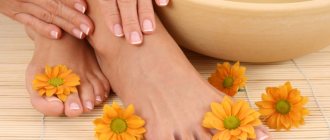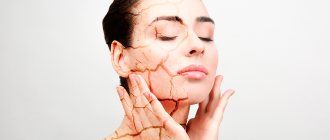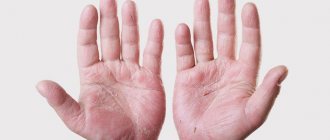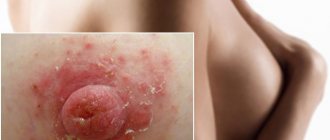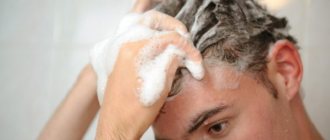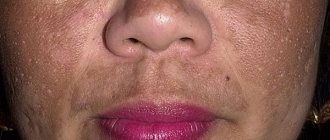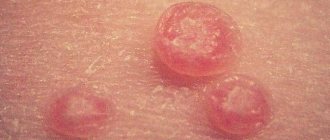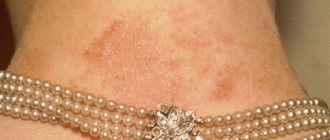We will look at the causes and treatment of this problem in more detail in this article. This common ailment of dry skin, firstly, not only has a cosmetic effect. Secondly, it can cause very painful sensations from deep cracks. Agree that our legs are subjected to unimaginable tests every day. We squeeze them into uncomfortable, non-breathable shoes and spend long periods of time on our feet. And despite all the daily stress, we pay attention to our feet only when we begin to experience discomfort and pain. To get rid of the problem, it is necessary to determine the cause of the loss of elasticity and the formation of thick skin on the heels. Perhaps one emollient cream will not be enough.
TOP 7 reasons for cracked heels
When walking, not only bone and joint formations, but also the covering of the foot are subjected to increased stress.
During movement, the skin stretches and contracts, deforming its own cells. The lateral surfaces of the heel, where the greatest tension is created, are subject to particular changes. When hyperkeratosis joins these processes, the stratum corneum thickens significantly. Moreover, as the size increases, its elasticity is lost, and accordingly, under normal loads, the skin begins to crack and burst.
So, what causes cracked heels? Here are the TOP 7 main reasons in adults:
- Fungus. Mycosis of the feet is one of the most common ailments. A high risk of infection occurs among those who visit public beaches, swimming pools, and showers without shoes. Spores are well preserved in a humid environment. Very often, fungus develops in people with an active lifestyle; this is constant sweating of the feet. Since overheating almost doubles the likelihood of developing the disease. In addition to cracks, dermatophytosis is manifested by itching, burning, and deformation of the nails.
- Diabetes. With “diabetic foot” the changes are characterized by the absence of pain. Glucose not only disrupts tissue trophism, but also affects nerve fibers, changing sensitivity. Regular deterioration of blood supply leads to changes in the skin of the legs. After all, blood supplies not only oxygen, but also all nutrients. Diabetes can also manifest itself as dry skin, the formation of ulcers, abrasions, and deep cracks. Possible foot deformity - hammertoes or hooked toes.
- Hypovitaminosis. Insufficiency of vitamins A (retinol), E, and the trace element zinc can lead to excessive dryness, decreased elasticity, and degenerative changes.
- Anemia. Iron deficiency not only affects the oxygen supply to tissues. The microelement is also found in tissues, taking part in the formation of proteins and enzymes. If it becomes insufficient in the body, the division and structure of cells is disrupted, leading to dystrophic changes. Epidermal cells, which are renewed quite often, are most susceptible to negative influence. Skin manifestations of iron deficiency anemia include.
- Problems with the spine. Often, radicular symptoms disrupt the innervation of the lower extremities. Almost the entire process suffers, which makes the skin on the legs thin, vulnerable, and with poorly healing wounds. Typically, such problems begin with prolonged compression of the root, especially with compression of several formations.
- Skin diseases - ichthyosis, psoriasis, plantar keratoderma. The most extensive factor that changes the skin on the heels. With dermatoses, the skin dries out, becomes susceptible to external influences, and becomes inflamed. Any impact can provoke microtrauma, which subsequently develops deep skin damage - a crack. Moreover, they often become gateways for secondary infection, which only aggravates the problem.
7) External factors. Usually these are “provocateurs” of problems, which, with constant exposure, can cause damage to the integrity of the skin of the heels.
What can cause cracks:
- Obesity – excess weight significantly increases pressure on the foot. In addition, this condition is often accompanied by metabolic disorders, which also negatively affects the skin.
- Tight, uncomfortable shoes – incorrect selection of shoes can result in increased, uneven load. Moreover, not only excessively narrow shoes are dangerous, but also worn-out heels and worn-out pairs. In the latter, the leg is not fixed, so when walking it constantly rubs, which provokes roughness and other “joys”.
- Deformation of the feet - flat feet, hallux valgus, clubfoot - also lead to a redistribution of the load and, over time, provoke the appearance of calluses, corns, and hyperkeratosis.
- Standing work or prolonged stay “on your feet” - in such cases, increased pressure is observed almost every day, the skin cannot cope with the resulting microtraumas, triggering increased reproduction of cells of the stratum corneum, and the old ones, due to active growth, do not have time to exfoliate, leading to roughness and dryness , and subsequently – to cracks.
For a more detailed analysis of why heel damage occurs, we will consider each of the reasons separately.
Diagnostics
First of all, fungus and skin diseases should be excluded. To do this, go to a skin and venereal disease clinic, where they will scrape the skin to detect mycoses.
You should also take a biochemical and general blood test, as well as a glucose tolerance test.
For patients with diabetes mellitus, it is necessary to take a Doppler test of the vessels of the lower extremity.
Test norm
| Name | Indicators (norm) |
| hemoglobin | 120 g/l or more |
| glucose | From 3.3 to 5.5 |
Treatment
Before you begin to get rid of unpleasant symptoms on your own, it is recommended to undergo a thorough diagnosis. After all, if the reason lies in mycosis, then cosmetic procedures will bring only a temporary effect, and salon pedicures are generally contraindicated for patients with diabetes (there is a high risk of cuts, which quickly turn into trophic ulcers).
At the very beginning of eliminating cracks, it is necessary to get rid of provoking factors - choose comfortable shoes, start using special orthopedic insoles, and in case of serious problems, consult an orthopedic doctor.
It is necessary to carefully monitor hygiene. This is especially important for patients with diabetes.
Reminder for foot care with diabetes:
- Wash your feet in warm (not hot) water daily, drying thoroughly after the procedure. Particular attention should be paid to the spaces between the fingers.
- Every day, inspect your feet for cracks, abrasions, wounds, and scratches.
- If your feet are prone to sweating, treat them with talcum powder or baby powder after each toilet.
- Do not use scissors, tongs or other tools with sharp edges. All procedures are carried out only with a nail file.
You should adjust your diet to include vegetable oils, eggs, and butter. These products are rich in vitamin A and E, zinc, which will improve skin condition. It is also recommended to additionally take medications with these elements, either separately (Aevit) or as part of complex vitamins. Fish oil can be a good source of these nutrients (you can read more about the benefits of the supplement here).
If anemia is established, it is necessary to increase red meat and liver in the menu. Apples, according to recent research, do not contain iron, but they help improve its absorption. Before eating meat, you should eat a couple of pieces. Iron is extremely poorly absorbed due to the difference in valency. Severe forms are recommended to be treated with special drugs - ferretin, hemofer, sorbifer.
Foot fungus therapy
It is extremely difficult to get rid of this disease. Treatment should be comprehensive and include removal of external manifestations (cutting off scales and seals, removing affected nails). Hyperkeratosis is usually removed using chemicals - applying lactic and salicylic acid, baths of soda and soap.
You should definitely use antifungal ointments, varnishes - miconazole, clotrimazole, etc. If the course is persistent and the proposed creams do not help, then systemic antimycotics are prescribed - fluconazole, ketoconazole, etc.
Metabolic disease
With age, it is more difficult to keep the skin toned, and women's metabolism is disrupted. Therefore, at the first signs of menopause, it is worth monitoring your skin more carefully, as it loses more precious moisture.
How to treat cracks?
You need to seek help from a specialist. A dermatologist will help determine the cause of cracked heels and prescribe appropriate treatment. If necessary, he can refer you for a consultation with an endocrinologist or gastroenterologist.
If a number of skin or fungal diseases are detected, the dermatologist will be able to prescribe a course of special treatment and give recommendations for caring for the skin of the feet. In some cases, with particularly deep cracks, which can form due to diabetes mellitus and other serious diseases, antibiotic ointments are recommended to the patient.
Ointments for the treatment of cracks
TOP 7 ointments for treating cracked heels at home:
| Name and mechanism of action | How to use it correctly |
| Radevit ointment (contains vitamin E, vitamin A, vitamin D2, emulsion wax and glycerin). The ointment stimulates skin regeneration and has an anti-inflammatory and disinfectant effect. Vitamins E, A and D2 promote rapid restoration of damaged tissues | Radevit is applied in a thin layer twice a day. Before using the ointment, the skin should be treated with an antiseptic. |
| Balzamed ointment (contains provitamin B5, vitamin E, vitamin A, glycerin and lactic acid). It has a moisturizing and nourishing effect on the skin of the feet, preventing the formation of cracks, redness, and irritation. Vitamins A and E increase skin resistance to infections and damage | The ointment is applied effortlessly to the area of cracks using massaging movements. The drug should be used daily, after water procedures. |
| Lamisil cream . Active ingredient terbinafine 1 g. The cream fights infection, prevents and destroys fungus. Promotes rapid healing of cracks and restoration of affected tissues. | Apply a small amount of cream to problem areas once a day. Before using the cream, feet should be washed with warm water and dried with a towel. |
| Gel Zazhivin (contains tea tree essential oil, milk thistle oil; vitamin F and sage extract). Promotes rapid healing of cracked heels, has a wound-healing and bactericidal effect. | It should be applied before bedtime with massaging movements on pre-washed feet. |
| BioAstin cream (contains flax oil, sage extract, mint extract, clove essential oil, tea tree essential oil, urea and allantoin). It has an antifungal effect, fights infections, protects the skin from pathogenic microflora. The oils contained in the cream have a softening effect. Extracts and extracts from plants promote rapid healing of cracks | Apply the ointment to the cleansed skin of the heels with massaging movements. |
| Emergency cream (contains petroleum jelly, wax, glycerin, allantoin, olive oil, vitamins F and E). Has a healing and bactericidal effect. The herbal extracts included in the composition accelerate the healing of cracks. Oils and wax soften and nourish the skin of the feet. Vitamins activate the restoration of damaged skin. | The cream is applied to the affected areas. Before applying the cream, the skin of the feet should be steamed and treated with pumice. Secure the crack on top with adhesive tape, tightening its edges. Wear cotton socks. |
| Dardia Lipo Balm (contains urea, microcrystalline wax, paraffin, petroleum jelly and corn starch). Urea in the cream combats dryness, effectively softening rough skin. Wax and paraffin normalize the water balance of the skin. The cream has a restorative effect, promotes the rapid healing of cracks | Apply with circular massaging movements. Use as a nourishing cream twice a day. |
Cracked heels can cause a lot of trouble for their owner and become a gateway for infection. Be sure to fix this problem! After getting rid of cracks, do not forget that the best measure to prevent their reappearance will be measures to constantly care for the skin of your feet.
Folk remedies for cracked heels
Not everyone prefers store-bought medications and wonders how to treat cracked heels with folk remedies. There are many methods and recipes for home therapy for this problem. We have selected the simplest and most effective ones.
Foot baths
The baths are designed for steaming the stratum corneum. This will make the skin more responsive to procedures to remove roughened dermis. This therapy is very pleasant and gives a lot of pleasure.
However, like any other methods, it has contraindications:
- wounds, skin damage;
- allergy;
- individual intolerance;
- the first day after the pedicure.
Making baths is very simple. Water at a comfortable temperature is poured into the basin, and agents are added, depending on the type of therapy. Then the legs are lowered into the basin and steamed for 10–15 minutes.
For medicinal purposes, baths are done daily. Then - once a week to maintain the result.
Additives for baths in the ratio of 2 liters of water:
- peat oxidate;
- milk + starch 2 tbsp each;
- hot whey;
- 2 tbsp. soda + a little liquid soap;
- 30 grams of starch;
- about 1 liter of chamomile or calendula decoction;
- herbal mixture of St. John's wort and nettle.
To soften the skin, regular bath salts, which are sold in any cosmetics store, are also suitable.
Compresses and masks
Compresses and masks are applied after baths or after showers. As part of the course of therapy, procedures are performed daily, and then 1–2 times a week.
There are 10 basic recipes:
- A mixture of glycerin and apple cider vinegar (2:1).
- 100 gr. mix flour with 1 tbsp. l. vegetable oil and 30 gr. melted honey. The mask is applied at night, and socks are put on top.
- Curd compress from one ingredient.
- A mixture of any cosmetic oils. Squeezes made from olives, grape seeds, corn and jojoba are best suited.
- Vitamin E capsules.
- Butter.
- A mixture of grated apple, beer and butter. For one fruit you need 100 ml of beer and 2 tbsp. l. oils
- A mixture of ammonia 10% and glycerin (1:1).
- Medical bile.
- Chopped celery and butter (1:1).
It is recommended to wear natural cotton socks over the compresses to allow the skin to breathe.
Natural ointments and creams
You can make your own creamy products.
Recipe 1. Ingredients:
- badger fat;
- decoction of celandine and calendula.
Preparation:
- The fat is heated in a water bath.
- The finished broth is poured into heated badger fat.
- The ingredients are mixed together.
After the mixture has cooled, apply it to the affected areas. The ointment should be warmed before each use.
Recipe 2. Ingredients:
- vinegar 9% - 50 ml;
- glycerin – 50 ml.
The components are mixed together and applied to the heels before bed. Cotton socks are worn on top.
Recipe 3.Ingredients:
- petrolatum;
- a mixture of dried herbs calendula and plantain.
The ratio of Vaseline and herbs is 1 to 10. The components are mixed together, and the finished mixture is applied to the skin of the feet.
You can add 1-2 drops of essential oil to ready-made homemade ointments for the best effect.
What to do with large and deep cracks?
If cracks develop on the skin of the foot, to provide first aid to yourself, you should take the following measures, which will give an excellent result in just 2 weeks:
- Buy Glue BF 6 (60-80 rubles) at the pharmacy, don’t be surprised, it is approved by dermatologists and recommended for use in this pathology. Apply a few drops to the clean skin of the crack along its entire length, wait until the glue dries. This is necessary so that the wound heals and does not deepen; in 5 days the crack will heal and the glue will be removed along with the keratinized layer of skin.
- Then you don’t need to do anything for 7 days. Afterwards, you should take baths in warm water and slowly, not at once, but gradually cleanse the foot of keratinized tissue.
- Immediately after the bath, apply creams with salicylic, lactic, and glycolic acid. You can use Zorka (veterinary) cream, which contains floralizin; this is a very effective remedy for cracks in the skin. Use moisturizers in the evening and during the day.
- The condition of the skin, including the skin of the legs, can be improved by consuming 1 tbsp orally on an empty stomach. spoons of olive oil, but it should be borne in mind that this method is not suitable for everyone, for example, it is contraindicated for people with gallstones (the oil has a choleretic effect).
Beauty salon at home
You can get rid of this problem in a beauty salon. Everything there is tied to skin treatment. Excess layers of skin are removed from the patient’s legs, and the edges of the wounds are treated using special techniques. However, there are procedures that can be performed at home. These include contrast baths.
Contrasting foot baths will also help.
Two containers are used here: one contains hot water, the other contains cold water. The legs are lowered first into one, then into the other. Here is the maximum amount of time you can keep your feet in water of a certain temperature:
- cold - 15 seconds;
- hot - 3 minutes.
Note! This improves blood circulation, increasing skin tone.
For therapy and prevention after washing your feet, you can use heated vegetable oils. Olive is recommended here: it is good to use anywhere on the skin. And while rubbing, you can also massage the area at the same time.
Olive oil will help moisturize your heels
Prevention
It is clear why cracks in the heels occur. Based on the reasons, you can minimize the risk of skin cracking (see photo) by following the following recommendations:
- Wear comfortable shoes made from natural materials.
- Buy cotton socks, knee socks and tights.
- Regularly treat the skin with pumice to remove the stratum corneum (once a week).
- Apply foot cream to your heels every day.
- Avoid walking for long periods of time without shoes on the ground or on a hot beach, so as not to injure the skin of your feet.
- Treat chronic diseases in a timely manner.
- Include enough foods rich in vitamins (fruits, greens, berries) in your diet.
Are you worried about deep cracks in your heels? Listen to the recommendations of dermatologists, arm yourself with advice from traditional healers, and carry out a course of treatment. Your efforts will not be in vain.
Anal fissure Diabetic foot - drug treatment and foot care at home Sunburn Neurodermatitis: causes, psychosomatics and treatment Allergic dermatitis Cheilitis
Recommendations from experts
To avoid unpleasant peeling and painful cracks, it is recommended to take into account several useful tips from dermatological specialists:
- Wearing the right shoes. Often, women's heels peel due to continuous wearing of narrow pumps or other high-heeled shoes. In addition, open shoes (sandals, flip-flops, etc.) leave your feet exposed to dust and dirt. Flying particles clog the epidermis, drying it out and making it rougher. Shoes should not rub your feet and cause calluses.
- Using softening foot baths. They make subsequent peeling more convenient and simpler.
- Drying feet after water treatments. Also, if your feet sweat during the day, you should immediately use fresh socks.
- Compliance with the principles of proper nutrition. Why do women's heels peel? Very often due to the lack of a balanced diet. It will benefit the entire body and skin. It is best to avoid excessive consumption of sweets and eat more vegetables, fruits and foods containing vitamins and proteins. Also, do not forget about the drinking regime and consume the right amount of water per day.
- Systematic pedicure. It is best to do it once every 10-14 days. To do this, it is recommended to have an abrasive file, pumice stone and a sponge on hand. The procedure can be performed on dry or moistened skin. After finishing the pedicure, the surface of the skin is treated with moisturizing cream or oil.
